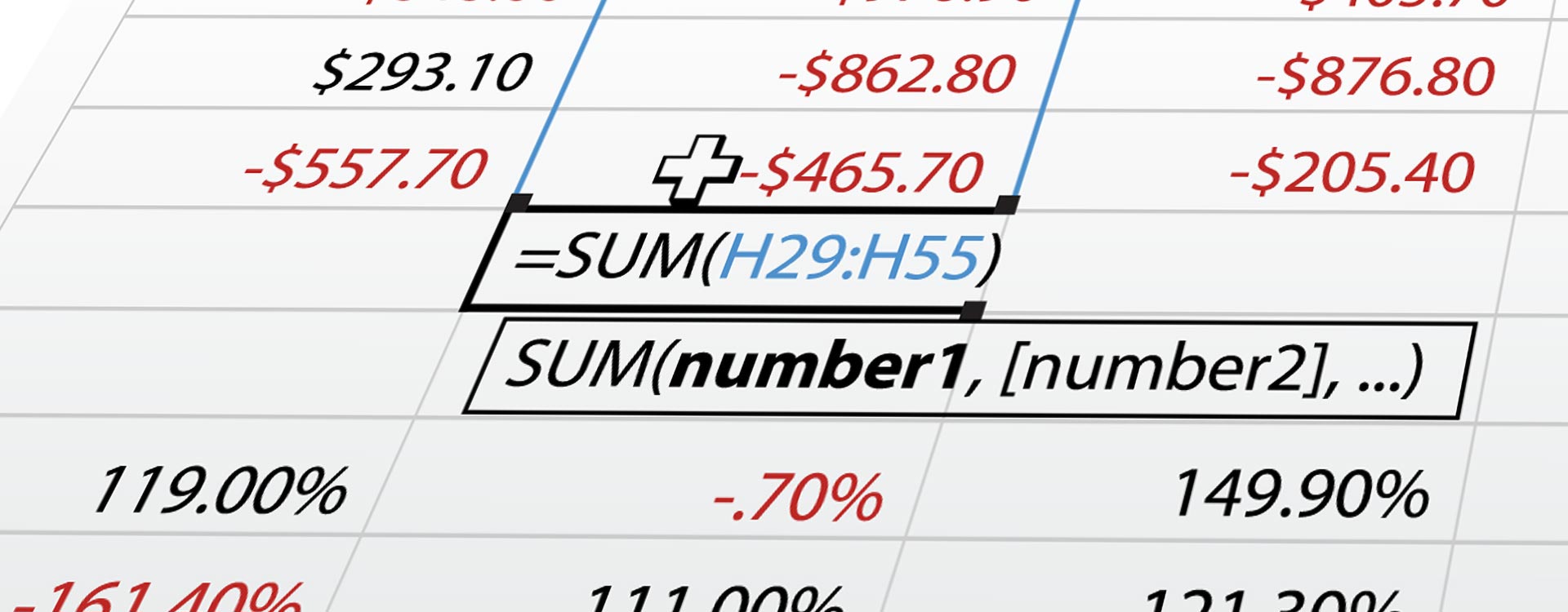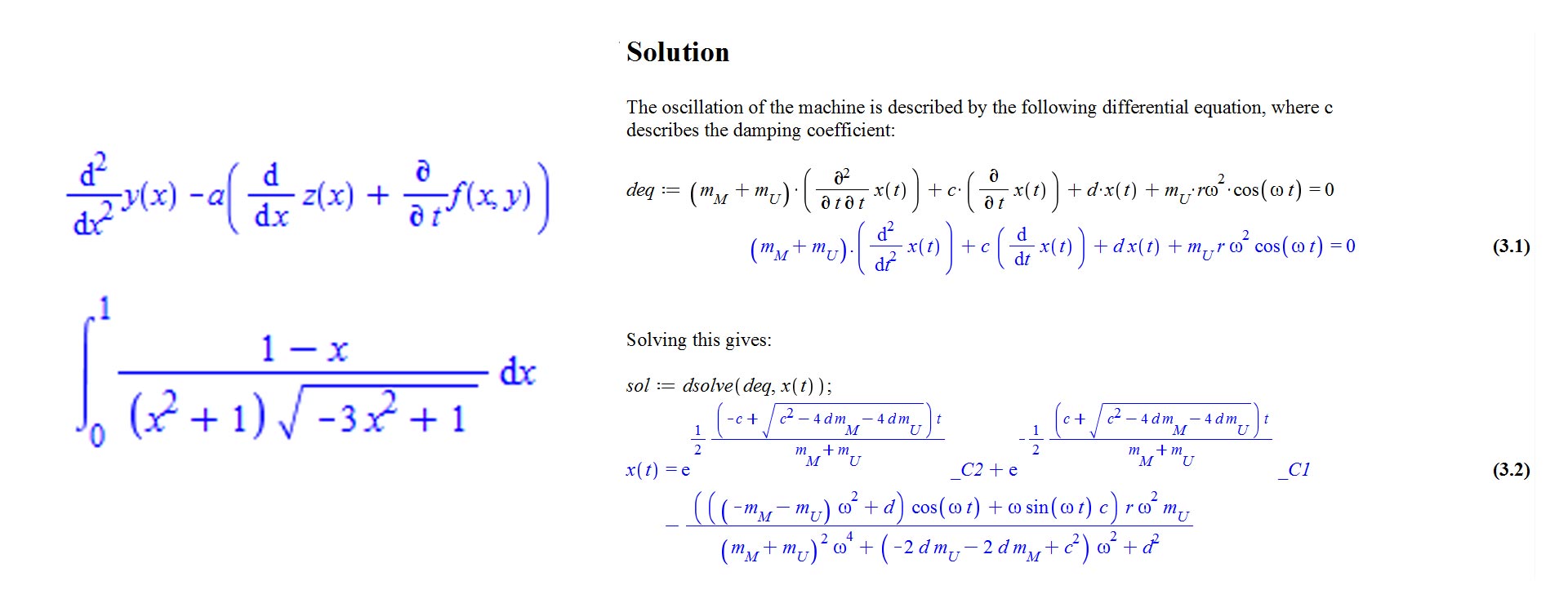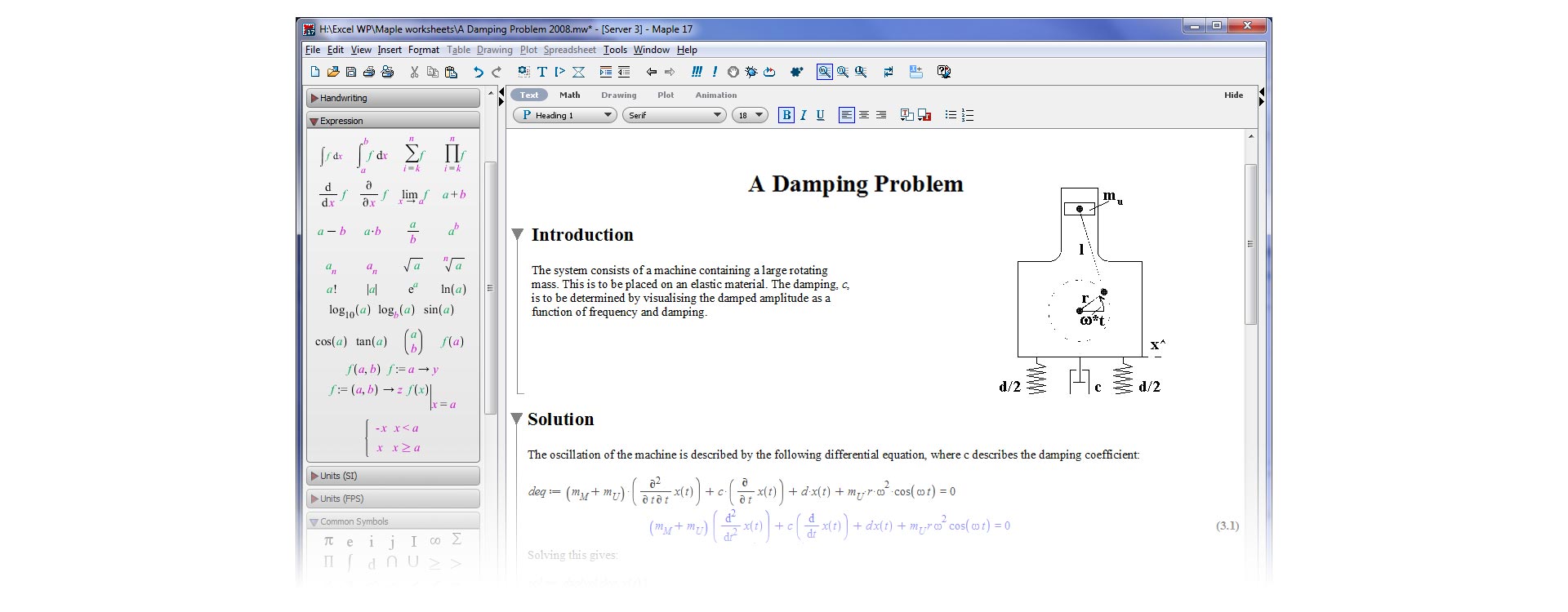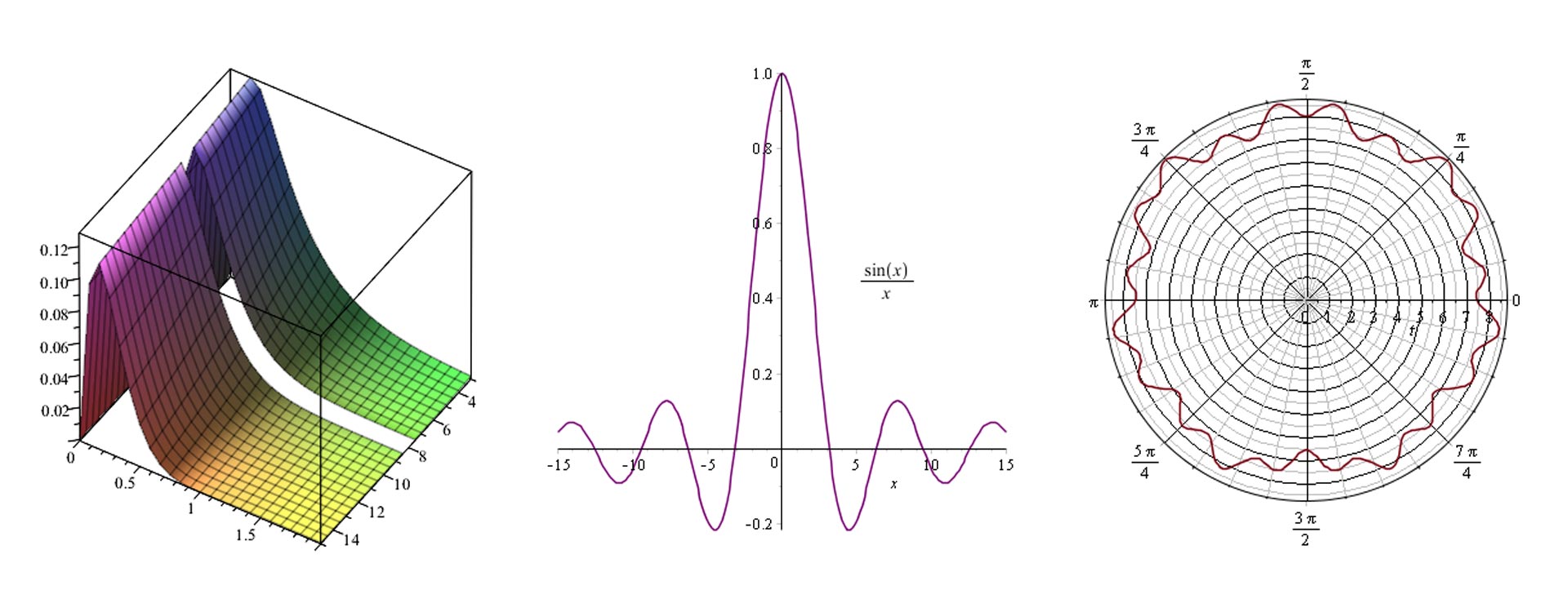
Maple
Powerful math software that is easy to use
• Maple for Academic • Maple for Students • Maple Learn • Maple Calculator App • Maple for Industry and Government • Maple Flow • Maple for Individuals





Every engineer has access to Excel®. It's so easy to open up a worksheet and start putting in some values. A quick calculation here, add a multiplier there, change this value because you have new information, and maybe redo the calculation with this number to see what the results would look like. The numbers look good, so you proceed with building a prototype.
Meanwhile, the spreadsheet is shared with another team, where someone adds a few more lines, changes some of the original values, and introduces a number of untraceable errors. A few months down the line, no one knows where any of the figures came from, yet project teams have been basing months of design work on the results of these erroneous calculations.
Cryptic formulas, coupled with a lack of visibility into where data is coming from and how equations are being solved, leave room for errors which result in undesirable and even disastrous consequences.

Consider the workflow of many engineers or technical professionals. During beginning stages, there's a lot of scratchpad work to be done as the concept moves closer to reality. Without enough care and attention, these calculations find themselves spread out over notepads, spreadsheets, and simply in the engineer's head. As the design moves forward, these calculations become bundled into all future decisions - for better or worse. What happens if an engineer moves on, or is on vacation? Without the original author, engineers can be left scratching their head and wondering where "that" number came from.
Then there is the JP Morgan Chase case of 2012 where a simple calculation error caused a reported loss of $6 billion. An existing spreadsheet was used as the basis to create a new one to model the volatility of trades for a new portfolio, and the calculations involved copying and pasting data between spreadsheets.
However, instead of dividing by the average of two given numbers to calculate the volatility of the trade, the sum of the numbers was used. Dividing by this larger number effectively reduced the risk assessment by a factor of two, which led to more risk being taken, resulting in exceptionally high losses.
The fact remains that while Excel has its uses, it was simply not designed for advanced mathematical calculations. Engineers and scientists need interactive math systems that enable them to write equations that describe problems using standard mathematical notation, such as ax2+bx+c=0, and then solve these problems by working with the equations in a natural way.
Maple is one of the best examples of an interactive math system. Built on a foundation of symbolic math, Maple is specifically designed for describing, investigating, visualizing, and solving mathematical problems. It offers a comprehensive range of solvers that cover all the principal areas of engineering math in a technical document environment that combines text, calculations, images, graphs, and more into a single document. Because Maple is designed for advanced mathematical calculations and because it allows engineers to capture the thinking as well as the results, Maple provides many benefits that Excel cannot.
The ideal tool for engineering projects is one that can handle complex calculations across a broad range of subject areas.
Excel is a business tool, which has evolved to handle some non-business calculations. Its Function Library now includes some basic math and engineering functions such as SIN, EXP, LOG, SQRT, etc. However these are very basic operations that do not come close to covering the scope of calculations required for a typical engineering project. Excel also enables users to write macros that extend its capabilities and automate frequently-performed tasks. However, macros work by manipulating the spreadsheet, which is not a natural way to approach problem solving.
Maple has over 5000 functions covering virtually every area of mathematics, including calculus, differential equations, statistics, linear algebra, and transforms. It supports symbolic, exact computations where variables do not need to be given values in advance, as well as infinite-precision numeric computations. Maple has world-leading algorithms that solve problems beyond the reach of any other software system, and efficient algorithms and tools for high performance computing and large-scale problem solving.
Maple also includes a full-featured programming language that can be used to create scripts, programs, and full applications. Designed for mathematical computations, it includes built-in mathematical data structures, operations, and functions specifically for manipulating mathematical objects and equations, making it ideal for advanced engineering calculations.

Don't struggle trying to describe equations, variables, etc in Excel. With Maple, you can easily express your calculations in natural math notation.
Learn More:
Maple's built-in equation editor allows you to express complicated mathematical problems easily using standard mathematical notation
Engineers want to describe problems in terms of equations using variables, constants, and operands, and then work through those problems in a logical manner. An effective tool must have the ability to support users in the way they want to work.
Excel does not support standard math notation. An expression like ((B12+2*$A$1)/A12)*2.1328 does not represent math in the way engineers express their problems, neither does Excel enable engineers to manipulate equations naturally. There is no flow to how equations are solved, and you have to jump around from cell to cell in order to see where a calculation is performed, and where the result is being used.
Using Maple, engineers can write equations and formulae in an intuitive and readable manner, using standard mathematical notation. Maple then lets you work through your problem in a natural way, with every step clearly visible, and well documented. You can see where input values are coming from and where results are being used. With Maple, you are 'doing real math' because Maple was developed for that singular purpose.
Maple enables engineers to solve mathematical problems in much the same way as they would when working them out by hand - albeit much faster, without errors, and with the ability to perform calculations that are impossible to work out by hand.
Engineering calculations involve values that have units - denoting mass, velocity, resistance, density, etc. Tools used for engineering calculations must be robust enough to recognize and correctly handle units in order to perform correct calculations. Many calculations also involve tolerances, where some values are known as falling within a given range. The ability to correctly manage tolerances as part of the calculation is an important part of reaching a correct result.
Excel is not designed for scientific calculations and does not handle units in an intuitive manner. You cannot perform calculations on numbers that include units. You can only convert a number in a cell from one unit to another using a function call such as =CONVERT(C5, "ft", "m"). Similarly, Excel cannot perform calculations that involve tolerances. For example, you cannot multiply two values, each with its own tolerance, and get a result that comes with its own tolerance information. At best, you can find out if two numbers are within a certain tolerance range of each other using the formula: =IF(ABS(A1-A2)<0.1,"OK", "out of range"), but this is rarely what you need to do.
Maple on the other hand, enables engineers to perform intelligent calculations that include units and tolerances. It prevents the use of incompatible units, and handles their manipulation to assign the correct unit to the result of a calculation. For example, consider the equation F=ma. In Maple, you can multiply a given mass by an acceleration, and Maple will give you the result in Newtons. Furthermore, with Maple, engineers can also perform calculations that involve tolerances, to account for variations in inputs and operating conditions, for example. With Maple, you can perform intelligent calculations by simply entering values with their tolerances and units, and Maple will perform the required calculations, work out the tolerance range, and assign the correct unit.
Having a verifiable development path is crucial to a company's success. It allows engineers to verify assumptions, reproduce calculations, and understand where results come from. Given that clarity and accuracy are vital for advanced engineering calculations, an environment that gives only the results is doing just a small part of the job.
Excel is designed for business calculations, and does not provide a clean way to add notes and comments into the workflow. It's not always clear where inputs are coming from, and why certain values are being used. You can add comments to a cell, but they are not easily identifiable. The reader has to hunt for a red triangle in the corner of a cell to know that there is a comment, and then hover over it to read the comment. The comment itself cannot include more than very basic mathematical expressions comprised of characters available on a standard keyboard, is not always visible, and obscures the document it is meant to explain. It is simply not a good way to convey important information.

Maple's smart document environment provides a rich environment in which to create a complete work history of a project. Your notes, comments, visualizations, and calculations are all in one document. You can easily see where inputs are coming from, what assumptions have been made, and understand why certain actions were taken. These documents are "live", so if the assumptions change, you can make adjustments to your parameters and formulas and re-compute your results within the original document. Serving as a record of all project activity, the smart document provides an open audit trail that helps to reduce the risk of errors and costly delays.
The Maple environment also helps to retain organizational knowledge. By documenting the entire project work flow, the knowledge gained over the course of a project is captured in a living document which can be referenced at a future date. So whether employees leave a company, or questions arise about why things were done a particular way, there is a record of the entire project to refer back to.

Excel was designed for business calculations and produces clean visualizations to view data. Excel can produce bar graphs, line graphs, pie charts, and histograms.
Maple was developed for advanced mathematical calculations, and includes over 170 plot types and options. In addition to the same types of visualizations that Excel produces, Maple produces plots that include implicit, contour, complex, polar, vector field, conformal, density, ODE, PDE, statistical, and more. Maple also generates dedicated engineering plots, including time and frequency domain responses, root-locus, and root-contour plots. Maple not only lets you capture 2-D and 3-D graphs and animations, but also lets you zoom and pan them as well, for better analysis of data. You can even perform real-time rotation of 3-D plots to literally view the data from a different angle.
Annotation tools are available for all 2-D plots - text, math and graphical annotations may be added to further illustrate the solution. You can even sketch directly onto a plot to highlight something of interest, or drag an equation onto a plot to add it to the existing visualization.
Excel on the other hand only supports text annotation for 2-D visualizations. Maple's wide selection of plot types and available visualization options enable you to visualize solutions, understand relationships, and communicate results in a form that is visually appealing and truly meaningful.
Different tools offer unique capabilities that enhance the outcome of a project. The ability to connect with third-party tools for data input and manipulation enables engineers to leverage the right tools for the particular task at hand.
While Excel lets you import and export data files, and interacts with other Microsoft Office suite products, it does not connect directly with other tools to take advantage of their niche capabilities.
Maple offers extensive connectivity with other tools. Maple can generate code for Visual Basic, MATLAB®, Java™, C, C#, Fortran, Perl, Python, R and JavaScript. This enables you to take your work and implement it in other tools - royalty free. You can even deploy to Excel! Maple also supports two-way connectivity with MATLAB®, providing direct access to all of the commands, variables, and functions of each product while working in either environment. Additionally, Maple also lets you connect to CAD systems such as SolidWorks®, Autodesk® Inventor™, and NX® - enabling you to apply Maple's computational power to analyze and optimize designs. Other forms of connectivity that Maple supports include database connectivity, the OpenMaple API, the ability to call another application from within Maple, and internet connectivity that enables you to retrieve information from online data sources, and incorporate that data into Maple applications. This wide range of connectivity options enables engineers to apply the right combination of tools for the optimal outcome.
When solutions, sometimes in the form of applications, are delivered to end users in a readable and readily-usable manner, they are more likely to use those solutions, and use them correctly. Also, when solutions can be easily modified and customized, project teams can use them as a starting point for new projects, saving time and money.
As previously discussed, Excel spreadsheets are opaque documents that can be misunderstood and misapplied by end users, and they can be challenging to modify correctly because of the difficulty in understanding what assumptions they embed and what exactly they are doing. Maple solutions are fully-documented, highly-readable documents, making it much easier for end users to read, understand, and use them appropriately.
Both Maple and Excel offer the ability to turn these documents into applications for end users, by including interactive elements such as input fields, drop-down lists, buttons, and check boxes. Maple also supports dials, gauges, and 3-D plots which are not available in Excel. These interactive options enable end users to insert required values and obtain customized results and plots based on their specified input. In Excel, free-form input is done in text-style input boxes, which can be used for numeric input or formulas in calculator-style input. Maple offers both text input and a math input field that allows the user to enter mathematical expressions using standard math notation. With standard notation, the input is visually verified much more easily and so fewer mistakes are made.
In both Maple and Excel, inserting the interactive elements into the document is easy, and similar. Programming those elements to complete their tasks is not. In Excel, the programming is done in VBA (Visual Basic for Applications) and the logic of the program involves manipulating spreadsheets - cell references and spreadsheet operations - not manipulating equations. In Maple, the programming is done in the Maple programming language, which is designed for mathematical calculations. As a result, code in Maple tends to be faster to write and easier to understand, debug, and modify. In addition, when it comes to modifying the applications, the Maple document already contains all the reasoning and assumptions that went into the original application, presented in a readable way, so changes can be made safely.
Once your Excel solution is ready, you can send it to other Excel users. Once your Maple solution is prepared, you have several deployment options. One is to share your documents with other Maple users, either directly or through a private group in the MapleCloud Document Exchange, a document sharing mechanism built into Maple.
You can also share your work with people who don't have Maple using the free Maple Player. With the Maple Player, your end users can view Maple documents, and use the interactive elements, such as buttons, entry boxes, and sliders, to perform computations and visualize results. The Maple Player can be used royalty-free by any number of users.
Maple documents can also be shared via MapleNet - a server-based deployment tool that allows you to publish Maple applications on a corporate intranet. End users interact with these applications through a web browser, in the same way they would in Maple. When you add or change a document on the MapleNet server, it is automatically available to all your end users, making it easy to ensure your end users are always working with the latest versions.
Whichever method you choose, Maple ensures that your teams can easily share documents, deploy applications, and communicate efficiently.
As the drive for innovation grows, companies are under pressure to deliver better products in less time and at lower cost. As a result, it is more important than ever to use the right tools to get the job done, the first time. While Excel is good for project budgets, it simply cannot handle the scope of mathematical computation required for advanced engineering projects. Engineering teams need robust and powerful interactive mathematical systems - tools like Maple, which have an inherent knowledge of multiple mathematical disciplines and are dedicated to solving mathematical problems. With the right tools, you can capture your thought process, minimize errors that lead to delays, control rising costs, and avoid unexpected outcomes. Just as you wouldn't head out to mow your lawn with a ruler and a pair of scissors, you shouldn't let the use of inappropriate software jeopardize the success of your engineering projects.